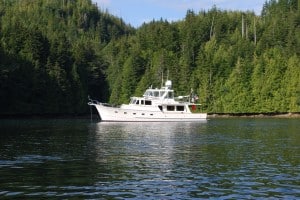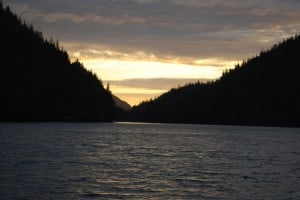It’s a good time in life when the most important question of the day is, “Is it time to pull the prawn traps?”
As I start to write this, we’re back in Booker Lagoon on the south side of Broughton Island, this time anchored with Couverden in the SE cove of this large lagoon . When we were in Port McNeill earlier this month, everyone was talking about Booker Lagoon and how great the prawning was – one cruiser talked about getting 300 prawns on a single pull (the most we had on our previous visit was 87), so that grabbed our attention. Our overall plan was to search out several new prawning spots we haven’t been to, but since it’s on the way we decided to stop at Booker Lagoon for a few days.
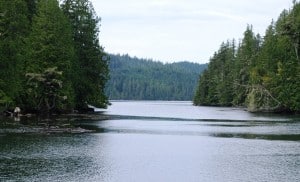
This time we approached the entrance to Booker Lagoon exactly at high water slack tide – we couldn’t see a ripple of current in either direction. Kap later said her knees were still a little shaky at coming through such a narrow and shallow entrance, but she did a masterful job of threading us through.
On our return, though, prawning has been just about the same as last time for us – 87 prawns on our first pull (but Steve on the Couverden got 140 on his first pull), and we stayed in the 80’s almost every pull after that. There are at least 8 other boats in the lagoon (or in the outer bay, going back and forth to their traps by dinghy through the lagoon entrance), so we suspect it’s getting a bit fished-out here. We had a meeting (over a glass of wine, of course) and decided we’ll move on after one more day here and try other spots.
(Some of the photos really need to be viewed in the larger format – don’t forget you can click on any photo to enlarge. Also, the photo captions will line up with the photos instead of being scattered throughout the text if you read this in the e-mail version)
But first, I should back up and catch up on where we’ve been since the last post.
Way back on July 30th, we departed Farewell Harbour and returned to Port McNeill for our flight home. We met up there with Steve and Shirley Clark, mooring Flying Colours and Couverden nose-to-nose. Shirley went home in Port Angeles to look after her aged mother at the same time Kap and I went home. Steve stayed behind to look after both boats – and otherwise spent his days fishing nearby from their dinghy for salmon.
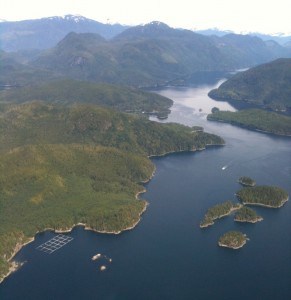
On our flight home, the view of channels we’ve cruised on is very different from 1,000’ than it is at sea level. This is looking east up Havannah Channel, the waterway off Johnstone Strait that we use to get to Lagoon Cove. The square frames in the lower corner are fish farm pens – remember, “friends don’t let friends eat farmed salmon”, so if you’re on the West Coast and see Atlantic salmon at the store, boycott it because it’s certain to be farmed from here, and it’s wreaking havoc on the Pacific salmon ecosystem.
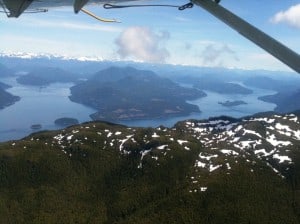
When I snapped this photo with my iPhone camera, we were climbing over the mountains along the east side of Vancouver Island. Johnstone Strait runs horizontally across the center of the photo, and the many channels that lead off it to the east towards Desolation Sound. The mountains in the background are on mainland Canada.
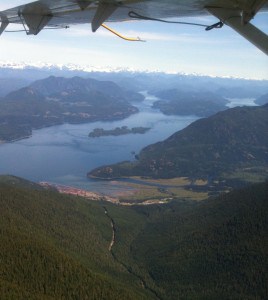
This view is along Johnstone Strait, with the fishing village Kelsey Bay inside Salmon Bay in the foreground. In the center of Johnstone Strait lies Helmcken Island, with several anchorages you can duck into if the weather turns sour. Johnstone Strait divides into Current Passage and Race Passage around the island, creating strong whirlpools when the current is running in either direction, constantly swinging the bow 20° in either direction from your course line. Chancellor Channel leads upward from it, and is one way to get to Blind Channel Resort.
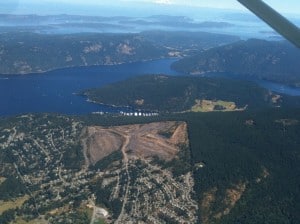
We passed by Maple Bay (center of photo, with the marina), a marina we stayed at two years ago and really enjoyed it. In the upper half of the photo is Saltspring Island, with Burgoyne Bay almost splitting it into two islands. At the lower half is the town of Maple Bay – note the terraced mining area just across the ridge from the marina, with houses built right to the edge of it.
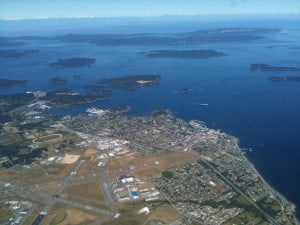
On the way south, we passed overhead of Sidney, B.C., where our summer cruise normally begins and ends. Sidney is at the northern tip of the Saanich Peninsula, and home to Victoria International Airport at the lower left. Victoria is 14 miles to the south. Downtown Sidney is near the marina to the right of center, and it’s where we moor during our initial trip provisioning. The cluster of marinas on the left are Van Isle, where Delta Marine is tucked deep into the bay – it’s where we get some of our work on Flying Colours done. The U.S./Canada international border runs along the right side of the photo, and San Juan Island is just off the upper right corner.
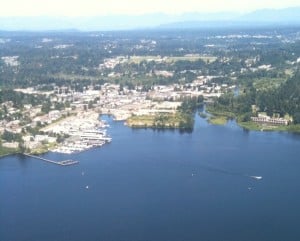
Our flight destination – Kenmore Air Harbour at the north end of Lake Washington. The airline’s docks are at the left side of the indentation at center left of the photo. Our approach was over Bothell, then a steep descent on final for a landing to the south.
Our Kenmore Air flight to Seattle was very interesting. As we loaded aboard the 8-passenger turbo Otter, our pilot said the winds were very favorable, so he planned to fly “high and fast”, expecting our arrival to be about an hour earlier than scheduled.
The pilot admitted to being allergic to cats, plus another passenger directly behind the cockpit had a dog on her lap, so the pilot asked that we ride in the rear two seats. There was room between the two seats for a third seat, but instead it was an aisle giving access through a web barricade to the luggage area behind us. This allowed us to have ZuZu between us in her Sherpa bag on the floor. We could hear her meow over the loud engine noise of the Otter, and it was obvious she wasn’t happy. It’s loud enough in a deHavilland Beaver or Otter – even in the turbofan models – that you need ear plugs, but obviously a cat won’t stand for that (Gator does when he flies with us), so I imagine the noise assault on her ears after a 2½ hour flight is pretty severe.
The flight was unusual in that we didn’t fly low (500-1,000’ above water) – and high and fast to a Kenmore Air pilot is at 2,500’ – he set a course down the center of Vancouver Island rather than over the water. I was on the left side of the aircraft, so I got to see Johnstone Strait from a vantage point very different from what I’m used to, as well as the coastal towns along the way. Kap was on the right, and could see all the way to the west coast of Vancouver Island, with its impressive bays that cut deep fjords into the island.

One reason for the timing of this trip home was to retrieve Gator from boarding at Camp Kelly, as Lisa Hart (his co-owner) wanted to show him one last time in the 10+ year old veteran class at the Evergreen Basenji Club Hound Specialty show at Argus Ranch. He won his class, which put him back in the ring for Best of Breed (in which he made the first “cut”, but didn’t take Best of Breed, which I sort of assumed he would).
The stay at home was mostly a blur – architect meetings, visits to Kap’s father, sorting through mounds of mail and paying a month’s worth of bills, and checking on the house construction progress. Eight days later we headed north to Kenmore Air Harbor for our return flight.
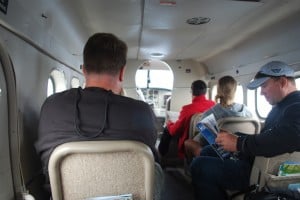
Here’s an inside shot of our deHavilland Turbo Otter that Kenmore Air flies to the Broughton’s. There are four rows of two seats each, and Kap and I were in the rear seats, with ZuZu on the floor in her Sherpa bag between us.
It was again on a deHavilland Turbo Otter, full of passengers now that vacation time to the summer cruising grounds is full on. First stop is Nanaimo, where Canada Customs is waiting on the dock to clear us. Kap and I are out first, so we clear first – the usual questions about carrying guns, tobacco, alcohol, etc, which we reply no to. We were loaded to the gills with supplies we can’t get in Canada, including 2 gallons of our favorite Häagen-Dazs Vanilla Chocolate Chip Cream that’s really hard to find. We kept our mouths shut, looked honest, and our bags never came out of the plane’s hold for inspection.
Then it’s a short walk to the little airline terminal house at the head of the dock for a pee and a candy bar while they add a couple hundred gallons of avgas for our flight north. When we returned we expected to depart, but we stood around on one foot, then the other, wondering why we weren’t loading up. The pilot stopped by to say that Customs hadn’t cleared our flight to depart, and someone noted that the Customs agents were at the head of the dock talking to one of our passengers. There was obviously a problem, and they weren’t clearing us until they sorted him out – and if they decided not to let him in, we’d be on our way back to the U.S. to return him.
Finally, he came down the dock, apologizing for being the cause of the delay . . . shaking his head and muttering “DUI’s” under his breath. As we loaded on board, he mentioned that he’d had a DUI in the U.S. back in 1992 – and didn’t even drink anymore – and that he’d failed to bring “his paperwork” with him on this trip. As we taxied out, the guy across from him related how he too had a DUI at some point in his past, and Canada Customs knows about it for anyone/everyone on board flights coming into the country, so you’d better carry your court documents about it with you on every entry to the country. In Canada, a DUI is considered a felony, and they’re very serious about it. Apparently, the guy who was questioned on our flight even had the DUI somehow removed from his record (maybe by doing some community service work), but he still has to carry the court papers with him – and this trip he’d forgotten to pack them. Whew! It certainly makes one think twice about driving with too much alcohol in the blood!

Blind Channel Resort as we circled over Mayne Passage on downwind for the landing. The white-roofed building on shore at the head of the dock is the restaurant and General Store. They have one main dock, with seven finger piers that allow one boat per side. On a busy day they probably have 25 boats at their docks, and in the evenings they’ll have 5-6 tables with guests in the dining room. The other buildings on shore are private residences for the four generations of the Richter family who own the resort, plus two cabins that are rented out to guests.
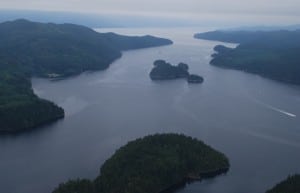
The start of a high approach to Pierre’s Echo Bay Resort. Beyond the splotchy-shaped island, the channel leads out to Queen Charlotte Sound. At the bottom center of the photo is the first island in the Burdwood Island Group – where we later spent a night at a stern-tie anchorage in a beautiful cove.
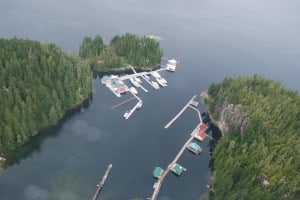
Pierre’s Echo Bay Resort is in the top half of the photo, and Windsong Resort (which Pierre also owns and operates now) across the way. The I-90 Floating Bridge section is the rectangular part at the right of Pierre’s, with the General Store occupying half of it, and a covered tent area where he holds his Saturday Night Pig Roast is on the other half. When the weekends roll around in mid-summer, the docks are packed full of boats, and he gets 100-150 people at the evening dinners.
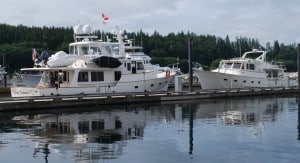
Flying Colours (left), nose-to-nose with Couverden at the Port McNeill Fuel Dock after our return from home. All looks well . . . for the moment.
Back in the air and heading north, our six other passengers had three different destinations before our final arrival at Port McNeill – a couple got off at Blind Channel, then another person at Pierre’s Echo Bay Resort, and a final stop at Sullivan Bay Resort. Finally, it was our turn, and we touched down at the Port McNeill Fuel Dock at 12:30PM. ZuZu was extremely relieved to be back on earth, even if she had to regain her sea legs aboard Flying Colours.
After we got settled aboard Flying Colours, Kap was walking back from the bow when she noticed about a dozen oblong splotches on the teak deck, just aft of the pilot house doors. She thought it was water, but when it didn’t seem any dryer after a while, she called me over to take a look. I stuck my nose to it, and there was no question about it – a strong, pungent diesel fuel smell. I popped my head over the deck rail and noticed there was also a large dark stain nearby on the dock, right at the end of a 3” stainless steel pipe that runs down the side of the dock. Obviously, something had happened in our absence, and it had to do with a diesel spill.
Since Steve had been watching our boat in our absence, I immediately jumped off Flying Colours and headed for Couverden, thinking that he might have some idea of what happened. I checked the stain on the dock, and it definitely was diesel, and fairly fresh. When I boarded Couverden and queried Steve about a diesel spill on our dock, and particularly the diesel stains on our side deck, his face took on an immediate look of shock and he put his hand to his open mouth.
“Oh, my god, I do know what happened, but I had no idea it might have gotten any on Flying Colours! Yesterday, the Thea Foss was moved over to our dock and moored across from us. She’s too big to fit on the fuel dock, and the pipe running down our dock is for fueling the very large yachts. When I returned late in the afternoon from picking Shirley up in Port Hardy from her flight back from Port Angeles, I saw Steve [the owner of the Fuel Dock] standing at the end of the fuel pipe and he was covered from head to toe in diesel – he was an absolute mess! Diesel was all over the side of Flying Colours’ hull, but Steve immediately washed down the whole starboard side of your boat before he even got himself cleaned up. He figured he had it all taken care of.”
Well, obviously not, and I immediately headed down the dock to find Steve (the Fuel Dock Steve).
Before I go any further, I should mention that the family that owns the Port McNeill Fuel Dock is absolutely wonderful. Steve is a young guy (30-ish) who took over management of the operation from his father, and he’s been a real force in rapidly building up this marina. Three years ago, all it consisted of was a long pier sticking straight out into the harbor, with nothing on it but the fuel dock operation (in fact, if you look at our SPOT map whenever we’re at Port McNeill, at the time of the satellite photo that Google uses, all you’ll see is that main pier). For years, virtually every cruiser who came to Port McNeill had to moor at the municipal marina next door, and they were so full – and worse, didn’t take moorage reservations – that oftentimes cruisers had to anchor out in the harbor for 2-3 days waiting for a spot to open up in the marina. The marina really focused on the commercial fishing fleet, and the cruisers took a back seat. Two years ago, Steve and his father expanded the fuel dock into a real marina, putting in floating dock space for at least 30 boats, good shore power on the docks, good potable water for cruisers who needed to fill their holding tanks – and most of all, they created a really good, friendly atmosphere. It’s really increased the ability for cruisers to “pop over” to Port McNeill for provisions, get some repairs done, and get fuel.
Anyway, I found Steve on a nearby dock helping another boat depart, and when he was free I mentioned the diesel splotches on our teak deck to him. He was horrified and as we walked back to Flying Colours he told me the story. Steve and the engineer from the Thea Foss were bleeding pressure from the fuel line before uncapping it to hook up the flexible hose and nozzle, and unknown to them the line still had a small bit of diesel in it. The pipe is pressurized, so they bled it first, and they capped the diesel off to a valve further down the dock from Flying Colours. For some unknown reason, when they uncapped the valve right next to Flying Colours, it must have still been pressurized, and also had a small amount of diesel remaining in it. As Steve cracked the valve, the release of the high pressure atomized the diesel, spraying it all over the place, and some of it had gone up and over the Portuguese rail on Flying Colours, landing on the teak deck.
We then discovered that a fine diesel film was all over the side of the pilot house, covering the windows on the starboard side. Steve wouldn’t let us help – he said it was his problem, and he’d get it cleaned up. With buckets of soapy water, he and one or two of his crew washed down the pilot house and got it all cleaned up. He was very apologetic, and we appreciated his attention to the problem, and we too thought he’d gotten it resolved.
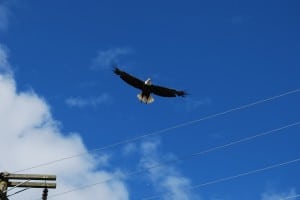
On one of my many trips to the store, I spotted our familiar bald eagle friend waiting for fish cleaning scraps. He’s on a glide getting ready to land on the power pole at the head of the fuel dock.
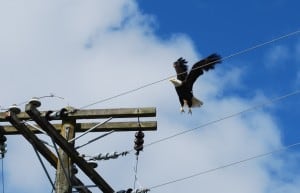
Landing gear is fully extended, tail feathers are spread wide, and man, look at the extension of his wings as he slows for a perfect touchdown on the top spreader board! These guys are incredible to watch!
The next morning while I was at the grocery store re-provisioning, Kap was fiddling around on the fly bridge getting Flying Colours ready to take out. That’s when she found a fine diesel film all over the fly bridge too, including the polycarbonate (i.e., plastic) fly bridge enclosure windows, as well as on the enclosure canvas fabric. When I returned from the store, we looked it over, and immediately called John Barrett, the owner of Barrett Enclosures in Seattle who built the fly bridge enclosure in 2009, to find out how to properly clean the polycarbonate windows of the diesel. John was immediately concerned, and said that diesel pits the polycarbonate if it isn’t cleaned within a couple of minutes of the diesel getting on it. He suggested we use really soapy water, and only use our hands to scrub it.
We immediately went looking for Steve, and after apologizing for about the 20th time for the problem, he came right down to start cleaning the fly bridge. It didn’t take long, though, to realize that the fears were true – after washing and drying the fly bridge windows, all four panels on the starboard side had thousands of splotchy crazes. The canvas cleaned up OK, but there was no question about it – the diesel had ruined the windows.
Anyway, to make a long story short, Steve told us he’d cover whatever cost there was to replace the polycarbonate windows when we returned to Seattle (most likely will cost a couple thousand dollars), and when we departed two days later he “comped” our entire moorage stay (which was a bit over two weeks, given that we’d gone home for a week, and that added up to around $900). Overall, a diesel spill isn’t fun, but when it happens and it’s someone else’s fault, how Steve handled this is exactly the way it should be. We’ll certainly be coming back, as well as telling everyone we know about their customer service.
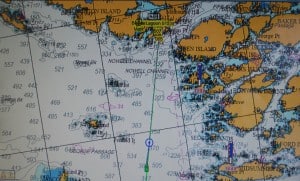
Our Nobeltec chart plotter screen image of Flying Colours (the green boat symbol at bottom center) on course across Queen Charlotte Sound for the entrance to Booker Lagoon on the south side of Broughton Island.
Finally, on Thursday, August 12th, we were ready to depart. Several other cruisers on the Fuel Dock talked about how good the prawning was in Booker Lagoon, so after several Happy Hour glasses of wine with the Couverden crew, we decided to head there to start our re-prawning efforts. One guy – who we thought was telling tall tales – said he got 300 prawns from one pull – and if so, that was fantastic.
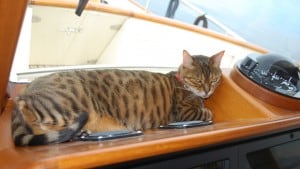
The look on ZuZu’s face might not seem happy, but when she’s tucked in for a good snooze behind the pilot house dashboard and all spread out, we know she’s a happy cruiser.
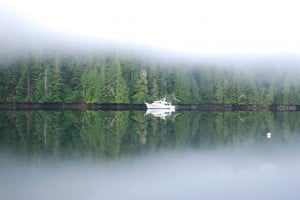
Nope! This isn’t Photoshop’d in any way. It’s an early morning shot of Couverden at anchor in Booker Lagoon, with low-level clouds (fog) halfway down the hillside behind Couverden, reflecting in the absolutely still water. That’s “A-oh”, our anchor sentinel buoy halfway out on the right.
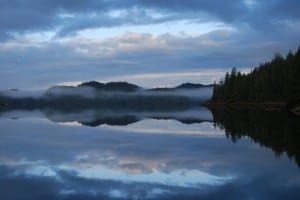
I never tire of the early morning photos when we’re at anchor – with glasslike water creating perfect reflections, making it hard to tell where the real world ends and the reflection begins. This shot looks west towards the center of Booker Lagoon. Our prawn trap buoy is one of the small white dots on the water’s surface at the left edge of the photo.
Unfortunately, we still think the 300 prawn story is a tall tale. We consistently got 80-86 prawns for the 5 pulls, and on our third morning as we were getting ready to depart, we only pulled 62. Interestingly, the guy from the Port McNeill dock who claimed 300 prawns per pull had returned, and he stopped by one afternoon in his dinghy after pulling his traps . . . and he said he had well over 250 prawns in a 5-gallon bucket at his feet. We think he never actually counted his catch, and was estimating well on the high side – besides, if he was getting as many as he claimed he’d be way over his limit.
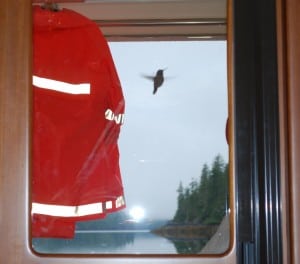
One morning at Booker Lagoon while shelling prawns at the salon table, my eye caught a glimpse of what I thought was a very large black blow fly at the cockpit door window. I looked up, and was amazed to see a hummingbird hovering outside. He flitted from window to window, always facing in towards me, and seemed to want in – or maybe he was seeing his reflection in the glass. My camera happened to be sitting right in front of me, and I managed to snap about a dozen photos of him. The orange blob is our prawning suits, hanging up in the cockpit. The white ball in the bottom of the window isn’t the setting sun – it’s my camera flash reflecting in the glass.
Turns out, we met this guy and his wife a couple of years ago at Blind Channel – they’re names are Stephen and Linda Nybank, and they’re really nice. They have a 38’ Bayliner named It’s A Good Thing, and found that he’s a retired U.S. Airways 737 captain, lives in Sandpoint, ID, and has been cruising here for at least a dozen years. He said he and his wife were heading for the Burdwood Island Group the next morning, and coincidentally, this was where we’d talked with the Couverden crew about going next. We decided we’d all head over there the next day, departing Booker Lagoon on the early morning low water slack.
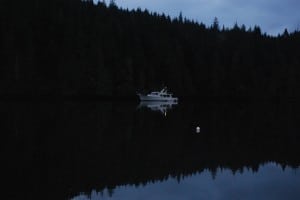
We were up before dawn on departure morning, and I couldn’t resist this shot of Couverden with the anchor light on as the morning sky just started to turn blue from black.
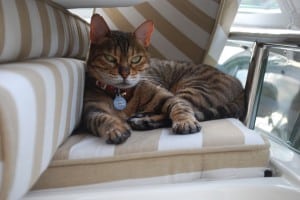
The morning we were ready to depart Booker Lagoon, we couldn’t find ZuZu anywhere. Since we were at anchor, we knew she had to be on the boat, but she just wasn’t anywhere to be found. She usually senses when we’re ready to leave, and hating the sound (or maybe it’s the vibrations) of the engines, she finds a good place to hide. Finally, Kap called out to me to bring my camera to the fly bridge. It had rained heavily the day before and with a pesky leak in the fly bridge canvas that we can’t seem to stop, we’d piled up the settee cushions in a corner. ZuZu was scrunched down next to a pile of cushions, hoping no one would find her.
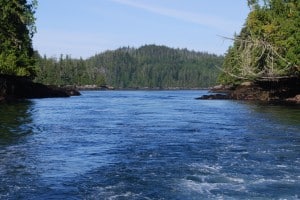
It’s a scant 50’ wide between the two rock sides in this photo. Flying Colours has a 16’ beam, so that only gives 17’ on either side – which isn’t much if the current pushes the boat one way or another as you power through. It’s definitely a white-knuckle ride!
Morning slack water at Booker Lagoon was scheduled for 9:30AM, so we were up before dawn to pull our prawn traps for the last time. By 7AM – it was still quite cold outside – we were suited up in our orange foulies (which are also very good for keeping out a cold wind), and headed in the dinghy to the center of the lagoon. Then it was back to Flying Colours to get all the prawn trap glimp stowed, and the dinghy brought back up to the dinghy deck and securely fastened down. After a second latte and a few minutes to relax, we started to bring up our anchor at 9:15. We were at the lagoon entrance exactly at 9:30, and were glad to see It’s A Good Thing heading through first – it’s always comforting to have someone else test the waters, particularly since this was a low water slack transit, and we were just one day after spring tide – when the tide lows are lowest and highest for the month (by as much as 3-4’ lower and higher than normal). They made their Securité call, and we followed them a couple of minutes later. As we entered the very narrow passage, we could see a bit of current coming at us, but Kap put some extra power on and we made it through with no problem. Minimum depth that we saw was 17’ (and we draw just a bit over 5’), so that doesn’t give you much room below the keel – and with the low water, the passage was a good 20’ narrower than it is at high water slack.
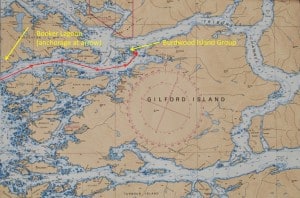
The cruise eastward on Fife Sound to the Burdwood Island Group from Booker Lagoon is a short 11 nautical miles.
The cruise to the Burdwood Island Group is just over 11 miles, and we puttered along at 8 knots to give us as much time as possible to run our water maker. We were below a half tank on our fresh water holding tank, and if we were to stay at anchorage for several days in the Burdwood’s we’d need full tanks. Couverden was even slower – dropping to trolling speed so that Steve could dip his fishing pole for a while – we’d heard that Coho salmon were running right now, and Steve has been really anxious to do some fishing.
One of our cruising guides indicates that anchoring in the Burdwood’s is good for a lunchtime stay only. Stephen and Linda, though, on It’s A Good Thing said otherwise – this is one of their favorite spots in the Broughton’s, and promised they’d show us the ropes. A stern anchor is almost a necessity, and since we’ve only done that once before in our five years of cruising (and then it was with the Nordic Tug), we really welcomed the offer. Stephen said there were 8-10 steel eyes secured into the rock faces just above the water line to facilitate stern ties, and he said he’d give us a hand with it as soon as he had his boat securely anchored and stern tied.
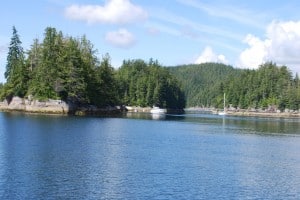
As we rounded the eastern side of the Burdwoods, we could see It’s A Good Thing getting into position to anchor, with the stern pointing towards the shoreline rocks. A sailboat is anchored nearby – and to our good fortune, departed just as we pulled in.
We lagged behind enough to give It’s A Good Thing time to anchor. You need your dinghy to take the stern tie line to the shore, so it made life significantly easier for us having Stephen there to help us with that.
As we turned into the narrow, shallow passage between the cluster of small islands – not to mention a lot of rocky bits sticking up everywhere above the surface of the water – a sailboat that was anchored about 100’ from It’s A Good Thing was just pulling up their anchor and they exited as we came in. We pulled near to It’s A Good Thing, and Stephen hollered over to us that the absolute best anchorage here was where the sailboat had just departed, and suggested to Kap that we position Flying Colours exactly where it had been. He suggested we drop our anchor and set it in about 60’ of water, with our stern between 20’ and 50’ from the shore. With Kap at the helm, I dropped our anchor as instructed, and by the time we had that done, Stephen was over in his dinghy to take our stern tie line.

It’s A Good Thing is at anchor, and Stephen in his dinghy has run the stern tie line to shore, through a steel ring set into the rock, and he’s now bringing it back to his boat to tie off.
We have a specially-built stern tie reel mounted on a rail on the dinghy deck of Flying Colours, with 500’ of floating polypropylene line wound on it. To stern tie, we bring the end of the line down to a hawse hole in the stern, then take the line to shore. Usually, you tie to a tree or rock on shore, but Steve had imbedded the steel rings in the rocks several years ago (and few knew about them). Once you pass the end of the line through the steel ring, you return to the boat with it and tie it off on a cleat. You’ve now secured your boat at anchor, plus to a fixed spot on shore, and don’t have to worry about swinging with wind and current. In tight places, many more boats can anchor without getting in each other’s way – well, except that you’re now cheek-to-cheek like RVs in a motor home park if it gets crowded.
As soon as we were secure, Stephen went over in his dinghy to help Couverden anchor and stern tie.
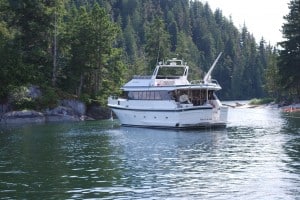
The butt-ugly Jody And The Kid are bow and stern tied, without an anchor down at all. Note that the bow line is tied to the anchor, which has been dropped below the bow pulpit a few feet, and then the line has been run to a tree on shore.
About an hour later, one of the ugliest tubs in the world pulled in – and we knew the Clampetts had arrived. We’d seen it at Port McNeill on a nearby dock – a horrible looking RV-style thing (it doesn’t look enough like a boat to call it one). It’s named – get this, Jody And The Kid – after a cowboy song title by Kris Kristofferson. It’s a charter boat, and aboard it was a hired captain and two couples who didn’t know the first thing about boating (and we questioned whether the captain does either).
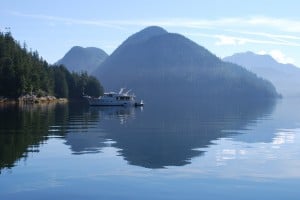
The view from where we were anchored, looking out to Tribune Channel, is awesome! Couverden didn’t feel comfortable with their stern tie, so later in the afternoon they untied and anchored a few feet further out from shore, allowing them to swing overnight on the wind and current.
To our absolute amazement, they pulled in between Flying Colours and It’s A Good Thing, and without first setting an anchor, they ran a stern line to shore with their dinghy and tied it off on a ring. Then they let that line out about 300’ (!), and again with the dinghy, ran a bow line to the other shore, tying it off to a tree. They didn’t drop an anchor at all, but instead, had the anchor swinging from the bow, with the bow line tied from it. This is a 70’ boat, probably weighing at least 80,000 lbs, and they’ve got it tied with two polypropylene lines that are about the weight of ski ropes. Geez! This is a disaster waiting to happen – and if they break loose they’ll almost certainly wipe out either Flying Colours or It’s A Good Thing. There ought to be a law about allowing the Clampetts into town!
After watching the bow/stern tie fiasco, we gathered up our prawn pots, got them baited, and headed out in the dinghy to set them. Stephen said the prawning here was either very good, or not good at all, and we wouldn’t know until we brought the traps up the next morning. He and his wife spent the remainder of the afternoon scouting for driftwood and announced there’d be a bonfire on shore in the evening.
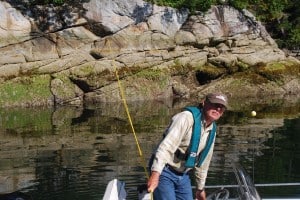
This is Stephen Nybank, who dropped by in his dinghy to chat with us the next morning. He has an interesting background – 10 years as a motorcycle cop in Walnut Creek (east of San Francisco), then he became a private Lear jet pilot for a charter outfit in the Bay Area (flying the likes of Francis Ford Coppolo back and forth to LA for movie filming), then a long career flying 737s for U.S. Airways (and they’re now retired to Sandpoint, ID).
In the photo of Jody And The Kid, there’s just a glimpse of a white beach at the right side of the photo. You never see beaches like this in the Broughton’s, and it’s not sand, but rather, made entirely of seashells. The First Nations natives created these over very long periods of time, most likely in areas where they frequently camped and made villages, probably to give them a nice shoreline to gather on, and also a good place to beach their canoes. The shells are broken into small fragments (1/2”-1” in size), and deep enough that you can scoop handfuls and not reach bottom.
After dinner, the six of us from It’s A Good Thing, Couverden, and Flying Colours dinghied to the shore on the back side of the island from the seashell beach. As I said earlier, this is a favorite place for Stephen and Linda, and they’ve spent lots of time here – enough, in fact, a few years ago Stephen brought a chainsaw from home and hacked through the downfall cedar trees and created a wonderful trail to the other side of the small island. There, he built a cedar bench on a nice rock outcropping that faces the evening sunset, and they’d go there for an evening glass of wine. We hiked the 15 minute trail to it, and it definitely is a wonderful place (unfortunately, I forgot my camera!). When we returned, Steve (from the Couverden) had a large bonfire going on the beach, and we roasted marshmallows and sipped a glass of wine. After the sun set, we returned by dinghy to our boats, as the temperature was dropping quickly.
Next morning, we checked our prawn traps – Steve came up totally empty handed, we had a meager five, and Stephen (this is 300-prawn Stephen) had six. With no sign that Jody And The Kid were leaving, and somewhat terrified they’d break loose any minute in the tidal current, Kap and I decided to leave Burdwood after our one night stay. Couverden too decided to leave, heading across Tribune Channel to an inlet, Viner Inlet, that seemed to captivate Steve. Kap and I made the decision to head for Sullivan Bay Resort for a night, then maybe go to Jennis Bay – a spot we’d wanted to go to for several years now – and maybe meet up with the Couverden in a few days at Moore Bay (on Kingcome Inlet) for more prawning.
The cruise was only 13 miles, so we were in Sullivan Bay shortly after noon yesterday. We’ve checked by e-mail with the marina owners at Jennis Bay for moorage space, and after they indicated there is plenty available, we’re heading there later today.

